PWC Expert: Be Prepared for Longer Tours
We were never out of sight of land on this day-trip, but we still packed the gear we'd need if something went wrong.
I consider riding a PWC from Long Beach, California, to Catalina Island a minor but worthy adventure, and when I made this day-trip last May it was just the right ride for an evaluation of the Honda F-15. It’s about 26 miles each way, and while you may never be out of sight of land, this is still the open Pacific. The water is cold and conditions can change quickly, and in some seasons this coast is prone to fog. So while a run to Catalina may be less than epic, it’s certainly more of a challenge than a few laps around the lake. I made the trip with Honda media-minder Tim Patnode, and the extra preparations we made are steps I would take before any long ride.
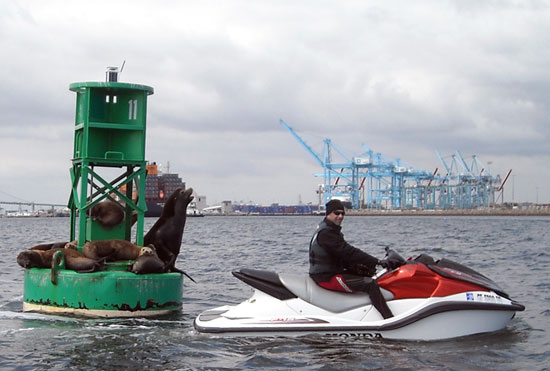
Honda media-minder Tim Patnode rides past sea lions guarding a channel mark, with the Port of Los Angeles in the background.
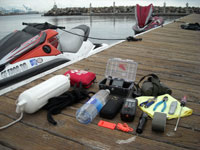
A spare GPS, VHF radio, and duct tape were among the extra items packed for a Pacific crossing from the California mainland to Catalina Island.
Be Prepared
Follow the old Scout maxim and try to be ready for any situation. For example, one of our boats was a Honda AquaTrax GPScape, which has a built in GPS navigation system, but we both also carried hand-held GPS units with the waypoint to our destination, Two Harbors, in the memory. If the on-board GPS failed, we were both covered, even if we got separated in a fog bank. We made sure both units had fresh batteries. We also each had a hand-held VHF radio, and each brought a cell phone. Thinking about the fog, we also each packed two low-tech devices, a little high-intensity signal whistle and an old-fashioned compass, just in case all the electronics failed us. Tim also brought a pair of binoculars.
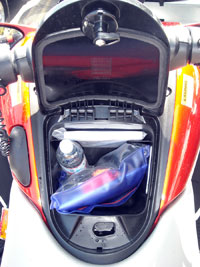
A small dry bag held my wallet, camera, note pad, GPS and cell phone, and that all fit into the generous Honda glove box, along with a bottle of water.
Sunscreen and a bottle of water are items I’d normally carry on a longer ride. On an ocean ride, the drinking water is important if conditions get rough enough that spray to the face is constant. Tim carried a small flash light and some basic hand tools we could use to make an emergency repair. We of course brought a nice, big roll of duct tape.
Tim had a small dry-box to hold his cell phone, GPS and wallet. I put that gear plus a small camera in a dry bag. We were both able to keep these items close at hand in the large glove box of the Honda F-15, which also stayed bone-dry during the trip.
Range and Weather
Fuel would not be a concern for this run to Catalina and back, which was well within the range of the AquaTrax. If the trip was going to be longer – say we decided to ride around the island, which can be fun on a nice day – I would make sure we could get fuel at Catalina, and that the 91-octane gas required by these boats was available.
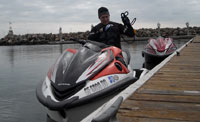
Nothing like boating in sunny California. Cool temperatures made a full wet suit and warm cap mandatory.
An offshore wind meant that the temperature was just about 50 degrees when we departed mid-morning. Note we were both dressed for conditions in full wet suits and wool caps. On this day, it was actually warmer back home in Wisconsin than it was in Los Angeles. Overcast skies didn’t help, either. We both packed a fleece and a dry shirt to pull on when we got to Catalina, and adopted a “stay dry” strategy on the ride, keeping our speeds down to both limit the wind chill and spray effect. Cruising at about 30 mph, we made the crossing in about an hour and a half.
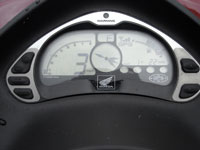
Honda GPScape system places a GPS nav screen in the center of the instrument display.
Navigation
We launched at the Cabrillo Beach launch ramp at Point Firman, near Los Angeles Harbor. When we reached the mouth of the harbor, which was some distance from the launch ramp, we punched in a GPS waypoint to use on the way home. We could see Catalina in the distance, and aimed for the saddle to the north end of the island, the location of Two Harbors. About five minutes out from the harbor entrance, I turned around and took a look back to pick out a few landmarks to remember for the return. This is a good tip for any long ride, as the view is always different when you are coming back.
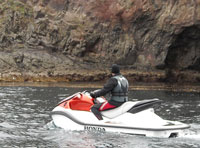
We took a short cruise along the bluffs of the Catalina shore before heading back to Los Angeles.
Float Plan
Before we left, Tim filed a “float plan,” simply letting a few people – his boss at Honda and his wife – know where we planned to go, when we planned to return, and where we parked the tow vehicle. This way if things were to go really wrong, they would be able to act promptly in contacting the authorities, and be able to give them this information to aide in either contacting us or starting a search. Filing a float plan is a good idea any time you go for a ride, even if it’s just down the lake for lunch or off on a wake-boarding session.
I have made this trip on other occasions, and it was always warmer but also much rougher. Once out into the channel, we encountered some stiff chop and low swells, but nothing too dramatic. After a quick lunch and a visit with the harbormaster, who had recently helped Tim host an ATV event on the island, we took a short cruise along the rugged shore, observed the seals, and turned for home. Despite the cool weather, we had a nice ride, and all of our emergency gear stayed stowed. This time, we beat the odds of Murphy’s Law. But we were ready.












